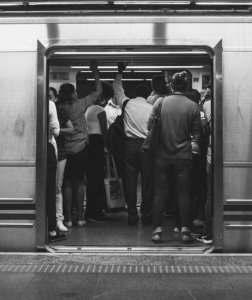A community that’s on the right tracks

Will I see you tonight
On a downtown train?
All of my dreams just fall like rain
Oh, baby on a downtown train
~ Tom Waits, Downtown Train
In my last OutTake, I wrote about the evolvement of “My Room” over time and generations of users. The room evolved in style and placement of furniture as our family grew in number and ages.
I was a New Yorker for ten years, riding the subways to and from my jobs and schools, and over the course of time, participated in an underground culture and community. Let me pull up a few elements of that subway culture.
First of all, I was fortunate to be a rider on an express not a local train. I lived on 16th Street off Union Square, and the train turned express after coming into Manhattan from Brooklyn and Queens. The riders from these boroughs, as well as from sections of Long Island, looked as though they’d put in a full day’s work already simply by riding the packed trains. They had worked up a good sweat without entering an office or touching a keyboard.
My office was on 59th street—the second stop from where I boarded my train at 14th Street. The best thing about it was that I could spend the previous night around the corner from my apartment at Max’s Kansas City listening to Lou Reed and the Velvet Underground, get out of bed at 8 and still make it to work by 9.
Since most of us on the train rode it at the same time daily, we created a culture as we waited for it to arrive. Our culture began on the train’s platform. We knew we wanted to be near the rear end of the train so that we could find an empty seat. Too far back on the station’s platform, however, meant we would miss the last car altogether and have to wait for the next train—usually about 15 minutes down the track. Given my tight travel schedule, however, it meant the difference between being on time or late for work, a fact I learned early. Fortunately, my copywriting skills gave me a bit of leeway, but I was not indispensable.
The ritual inside the car went something like this: Two of the regular riders held the car doors open until all the waiting riders could get on board. (That was different than what I remembered from my navy days riding the “fast train” in Japan. There, it was bodies shoving bodies until the doors closed, sometimes nearly decapitating a would-be rider.)
Once inside at 14th Street the daily ritual continued. We nodded to each other, having been in the same chamber together for numerous weeks. We noticed new members of the community and introduced them to the regulars. We offered our seats to elderly passengers. A number of us hung on to the vertical poles near the doors so we could make it off the train quickly. Even standing up at the pole, one could catch a quick catnap because the surrounding crowd would hold you upright until the train stopped. If you were lucky, you got to sit in one of the first two seats in the front end of the car against the conductor’s booth. Most seats were three across. These were only two, so you had more legroom.
At a point in my work career, my subway direction changed. My advertising agency dropped my account group (not an uncommon practice), and I enrolled in graduate school, which included an internship at a branch of the City University on Staten Island, a downtown subway ride to the ferry. Again, I was heading in the right direction at the right time of day. Staten Island was essentially a series of small-town suburbs of Manhattan, so commuters were flooding the Staten Island Ferry heading north to Wall Street and beyond.
And as Tom Waits noted, even the downtown trains were full with all these Brooklyn girls, many of whom hopped on to my old express and rode their way north to Midtown.
Heading south, below the financial district, I had the subway nearly to myself, with the exception of night-shift fire fighters and police officers assigned to stations in the northern boroughs. They were a largely conservative group, and I quickly learned to hold my tongue while they criticized New York’s impending liberalism before heading home to St. George, New Dorp and Tottenville.
Subways were worlds unto themselves. As one emerged from them, into daylight and city life, you seemed to be going from one planet to another, from the lifestyle of the tracks to that of the city. Frankly, I preferred train life.

